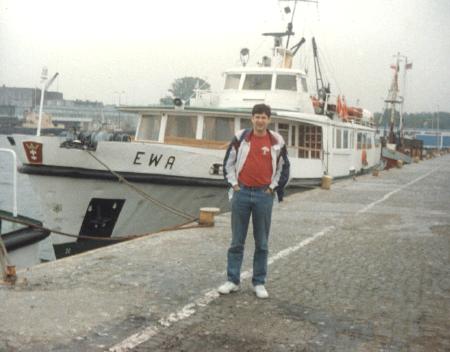My Travel Box article led to more interest than I expected both from longstanding and recent readers. It proves once again that I have no idea what resonates with a larger audience. So I’ll continue to write about what I find personally interesting and hope that a few of you join me for the ride.
Go ahead and take a quick look if you didn’t learn about the Travel Box. That’s because I’m going to use it as the conceptual basis for the current article with a twist.
I mentioned that people in England would be at a severe disadvantaged if they wanted to play the Travel Box game. They live way too close to the Prime Meridian in Greenwich. Therefore they would receive an artificially low score by birth. Loyal reader Hamish commented that maybe it would be more fair to use one’s own residence a a personal prime meridian. I agree. It’s a better indicator of actual east-west travel than an arbitrary selection at Greenwich. So let’s give that a try and see how it works.
A Personal Prime Meridian
Fortunately a major meridian once existed near my home. There the American Meridian ran through the dome of the Old Naval Observatory in Washington, DC. The United States used that meridian to anchor numerous state borders beginning about 1850. Later they switched to the universal standard circa 1884 when the International Meridian Conference agreed upon Greenwich.
I live maybe a couple klicks west of the imaginary line. I can even see the dome of the old observatory from some of the taller buildings in my neighborhood. That’s a situation that would be similar to many geography-savvy residents of the greater London area with respect to Greenwich today.
I pretended that somehow the Conference selected the American Meridian way back in 1884. Then I recalculated my Travel Box. The Old Naval Observatory sits directly atop Longitude 0.00° in that scenario instead of 77.05° West. Thus the hemispheric boundaries move nearly a quarter turn towards the west.
A Changed Perspective
So let’s move the Prime Meridian to Washington, DC and see what happens.
That certainly changes things. My east-west travel shrinks considerably and a dirty little secret becomes visible to the faithful readers of Twelve Mile Circle: I’ve never traveled to the Middle East or to much of Asia (Japan being the exception). I had vague plans to visit China several years ago but they never materialized. Hopefully I will correct that someday.
I’ve shaded the “new” eastern hemisphere on the map to help with visualization. Zero longitude runs directly through Washington, DC (the black vertical line). And 180 longitude runs directly through the Asian landmass (the red vertical line).
The International Date Line
This alternate universe would create all sorts of interesting dilemmas avoided entirely by the selection of Greenwich. The International Date Line now cuts across a large continental landmass rather than generally across open water. I don’t know if that was a major consideration back in 1884 but it certainly simplifies the situation today. Russia, Mongolia and China are cleaved nearly in half between the two hemispheres in the American Meridian model. Several other countries are clipped.
China’s Dilemma
China would face a particularly difficult choice because the entire nation follows a single time zone. Beijing falls into the western hemisphere on an American Meridian map. Would they be content to be the nation that ends the planetary day? Or would choose to throw their weight into the American Meridian eastern hemisphere to start the day? Kiribati switched and became the first nation to enter the Year 2000 so maybe China, in my alternate universe, would do the same as a means of demonstrating its ascendancy.
Either way, the International Date Line on an American Meridian globe would have some serious doglegs.
That’s an interesting divergence and maybe a thought worth exploring on another day. However, let’s get back to the original subject: my revised Travel Box using the American Meridian. It’s all about me, isn’t it? I’m kidding; that’s supposed to be a (poorly executed) joke. Anyway, moving right along…
Adjustments
North and South remain the same. The equator doesn’t change nor do the poles. Those are all constants during our lifetimes whereas the meridian is an artificial demarcation. The people of Gabon will have more difficulty scoring high than those of us living in temperate climates, and to them I apologize. However, I don’t think I’ll shift the model to place my residence on a fictional equator. It creates too many complexities even for a hypothetical scenario.
East

My most extreme eastern eastern journey within this new paradigm becomes Warsaw (Warszawa) Poland. It sits at 98.06° East of the American Meridian, which is 21.01° E of Greenwich.
This isn’t actually a photograph of Warsaw, it’s Gdansk. Actually, I spent most of my time in Krakow and a lesser amount in Gdansk and the Czech Republic. I reviewed my collection of photos from Warsaw and they weren’t all that remarkable. I saw a lot of post-war Soviet brutalist architecture.
Imagine rows of rectangular concrete communist apartment blocks that haven’t aged well and you’ll get the idea. I’m sure Warsaw is a lovely place, and it’s certainly historic, but I didn’t get to see those parts. I used Warsaw primarily for its international airport and I spent most of my time elsewhere. Still, it scores top billing as my easternmost personal attainment in an American Meridian world.
West

It’s hard to think of Japan as “west” but that’s what it becomes under the confines of an American Meridian. Thus, my westernmost travel using these rules brought me to Osaka. It’s 147.45° West of the American Meridian, while corresponding to 135.50° East of Greenwich.
My American Meridian longitudes ranged from 147.45° West to 98.06° East, a total coverage of 245.51°. Divide that by the available 360° and it equals 68%. That’s not as good as the 87% that I achieved using the Prime Meridian at Greenwich. Nonetheless it’s still within a respectable range.
I think I used too much brain power on this one. I need a nap.

Leave a Reply